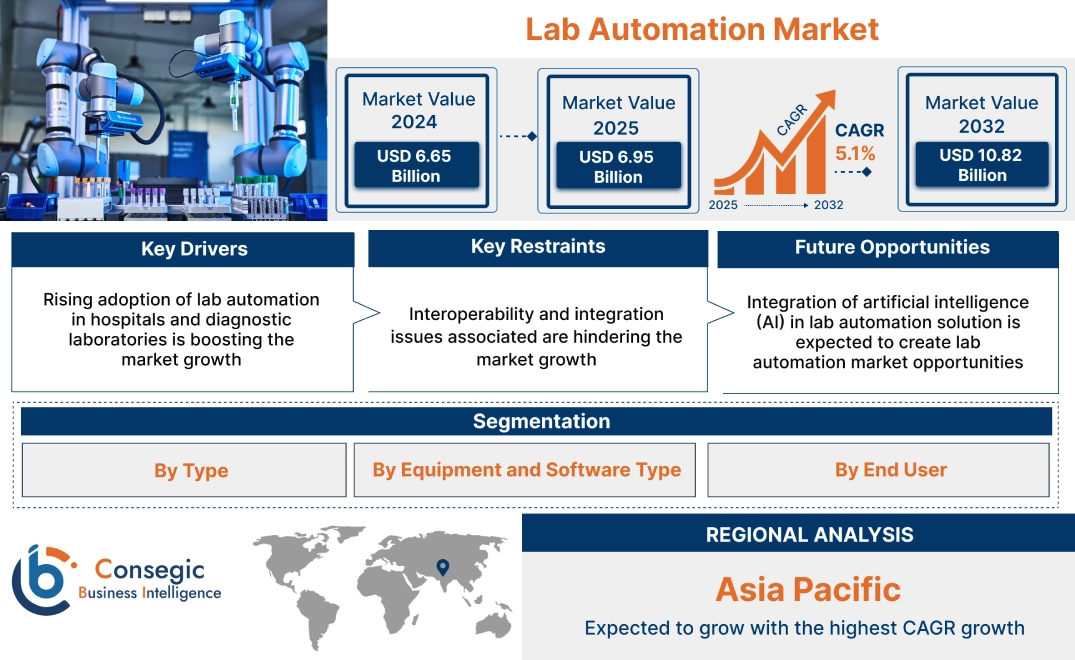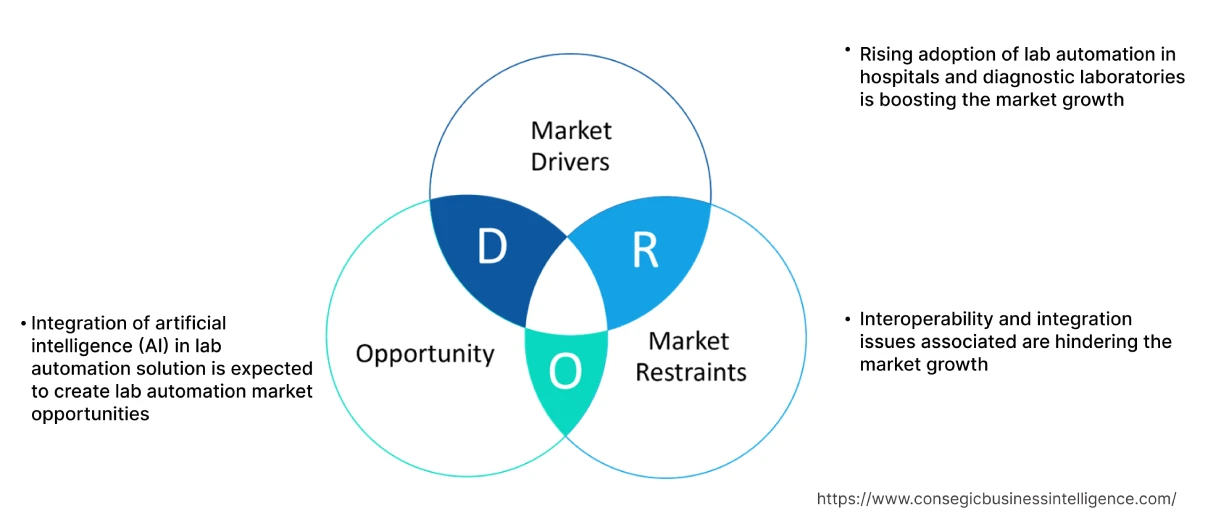- Summary
- Table Of Content
- Methodology
Lab Automation Market Size:
Lab Automation Market size is estimated to reach over USD 10.82 Billion by 2032 from a value of USD 6.65 Billion in 2024 and is projected to grow by USD 6.95 Billion in 2025, growing at a CAGR of 6.8% from 2025 to 2032.
Lab Automation Market Scope & Overview:
Lab automation involves using technology including robotics, instruments, and software to automate laboratory processes, minimizing human intervention and enhancing efficiency. It aims to improve accuracy, consistency, and throughput by automating repetitive tasks and managing data. Automation assists in automating time-consuming and repetitive tasks, freeing up lab personnel for more complex work. By automating processes, the risk of human error is minimized, leading to improved accuracy in lab processes. Automated systems perform tasks with more precision and consistency, leading to better reproducibility.
Key Drivers:
Rising adoption of lab automation in hospitals and diagnostic laboratories is boosting the market growth
In hospital laboratories, lab automation involves using robotic devices and automated systems to streamline processes, enhance efficiency, and improve accuracy. This automation replaces manual tasks with machines, leading to quicker results, reduced human error, and optimized workflows. It enables the efficient processing of samples, improves turnaround times, and enables a more focused approach to quality control and research.
- For instance, in May 2024, MVZ’s laboratory in Germany used ABB’s robots with lab staff to boost productivity. The automated laboratory table equipped with two ABB clean room robots fastens the pre- and post-analysis of blood samples along with lab employees.
Thus, the aforementioned factors are boosting the usage of lab automated systems, in turn driving the lab automation market growth.
Key Restraints:
Interoperability and integration issues associated are hindering the market growth
Interoperability and integration issues are major challenges in lab automation, particularly when integrating new automation with existing systems and managing data across different platforms. Lack of standardized interfaces, data inconsistencies, and difficulty in communicating between systems lead to operational inefficiencies and increased costs.
Additionally, different systems may use different data formats, making it difficult to exchange information smoothly. Integrating various devices and systems can create a larger attack surface, requiring increased security measures. Thus, the market analysis shows that the aforementioned factors are restraining the lab automation market demand.
Future Opportunities :
Integration of artificial intelligence (AI) in lab automation solution is expected to create lab automation market opportunities
AI in lab automation utilizes artificial intelligence algorithms and machine learning to automate various lab processes, improving accuracy, efficiency, and throughput while freeing up human researchers for more complex tasks. This integration allows real-time data analysis, predictive maintenance, and even automated experimental design and execution. AI algorithms analyze vast datasets generated by experiments, identify patterns, and predict outcomes, accelerating research and discovery. AI monitors equipment performance, predict potential failures, and schedule maintenance proactively, minimizing downtime and operational costs.
- For instance, in March 2025, R1 launched R37, an AI laboratory. The laboratory aims to provide intelligent automation solutions that will address challenges in healthcare reimbursement at an enhanced scale and speed.
Thus, the market trends depicts that the ongoing advancements and their integration with lab automated systems are projected to drive lab automation market opportunities during the forecast period.
Lab Automation Market Segmental Analysis :
By Type:
Based on the type, the market is segmented into modular automation and whole lab automation.
Trends in the Type:
- Rising adoption of whole lab automation for significantly improve efficiency, accuracy, and productivity in medical laboratories is boosting the lab automation market size.
- Increasing adoption of modular automation to enable easy adaptation to changing needs, cost-effective implementation, and improved precision and safety.
The modular automation segment accounted for the largest revenue share in the lab automation market share in 2024.
- Modular automation refers to a system of interconnected, self-contained modules that perform specific tasks, often in a laboratory or manufacturing setting.
- These modules are easily combined and configured to perform different processes or adapt to changing needs. They are building block approach to automation, allowing for flexibility and scalability in medical applications.
- Modular systems allow for easy adaptation to changing workflows and production needs, making it easier to scale the production as needed.
- Modular systems can be replaced or modified without disrupting the entire production line.
- Therefore, the market trends shows that the wide adoption of modular automation solution is boosting the lab automation market growth.
The whole lab automation segment is expected to register the fastest CAGR growth during the forecast period.
- Whole lab automation involves automating all stages of the testing process, from sample preparation to analysis and reporting, with minimal human intervention.
- This is achieved through integrated systems of robotics, software, and analytical instruments.
- This streamlines and automates end-to-end processes, including sample preparation, analysis, and report generation.
- This reduces the risk of exposure to hazardous materials and reduce the risk of repetitive strain injuries.
- Thus, the rising adoption of whole lab automation is expected to boost the lab automation market trends during the forecast period.
By Equipment and Software Type:
Based on the equipment and software type, the market is bifurcated into automated clinical laboratory systems and automated drug discovery laboratory systems.
Trends in the Equipment and Software Type:
- Rising adoption of automated drug discovery laboratory systems for increased efficiency, accuracy, and speed is boosting the lab automation market size.
- Increasing adoption of automated clinical laboratory systems for reduced human error and faster turnaround times.
The automated clinical laboratory systems segment accounted for the largest revenue share in the lab automation market share in 2024.
- Automated clinical laboratory systems streamline various tasks in a clinical lab, enhancing efficiency, accuracy, and safety.
- These systems automate tasks like specimen handling, analysis, and data processing, leading to faster results and reduced errors.
- Automated clinical laboratory systems handle specimens, including transport, processing, and storage, reducing manual errors and increasing throughput.
- Moreover, these systems manage and store data, including patient records, test results, and critical documents, ensuring easy retrieval and analysis.
- Additionally, automated clinical laboratory systems streamline workflows, reducing manual steps and freeing up staff to focus on critical tasks.
- Therefore, the market trends shows that the aforementioned factors are boosting the lab automation market demand.
The automated drug discovery laboratory systems segment is expected to register the fastest CAGR growth during the forecast period.
- Automated drug discovery laboratory systems streamline and enhance various stages of the drug discovery process by automating tasks including compound handling, high-throughput screening, and data analysis.
- These systems improve efficiency, reduce errors, and accelerate the drug development pipeline.
- Moreover, integrating various laboratory instruments and processes into automated workflows helps in improving efficiency and reducing manual errors.
- Thus, the rising demand for automated drug discovery laboratory systems is expected to drive the lab automation market trends during the forecast period.
By End User:
Based on the end user, the market is segmented into biotechnology and pharmaceutical companies, hospitals and diagnostic laboratories, and research and academic institutes.
Trends in the End User:
- Rising demand for lab automation in hospitals and diagnostic laboratories to streamline various tasks to improve accuracy, efficiency, and safety.
- Increasing demand for automation systems in research and academic institutes for sample handling, data collection, and analysis, allowing researchers to focus on more complex aspects of their work.
The biotechnology and pharmaceutical companies segment accounted for the largest revenue share of 40.01% in the market in 2024 and it is expected to register the fastest CAGR growth during the forecast period.
- Lab automation automates repetitive and time-consuming tasks, allowing researchers to focus on more complex and meaningful work.
- Automation enables higher-throughput screening, allowing researchers to test more samples and compounds in less time.
- Automation reduces labor costs, reagent usage, and waste, leading to significant cost savings.
- Standardized processes and reduced human variability led to more reproducible results, improving the reliability of research findings.
- Automation optimizes resource allocation and workflow management, leading to increased lab productivity and efficiency.
- Therefore, the market analysis shows that the rising adoption of automation systems in biotechnology and pharmaceutical companies is boosting the lab automation market expansion.
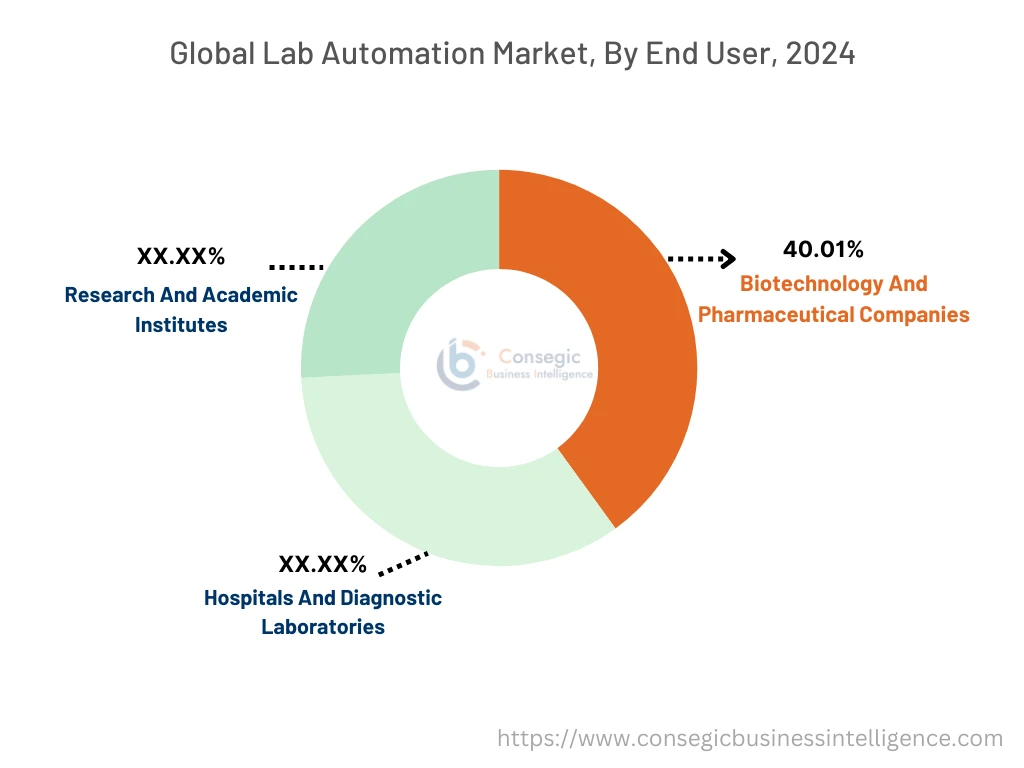
Regional Analysis:
The regions covered are North America, Europe, Asia Pacific, the Middle East and Africa, and Latin America.
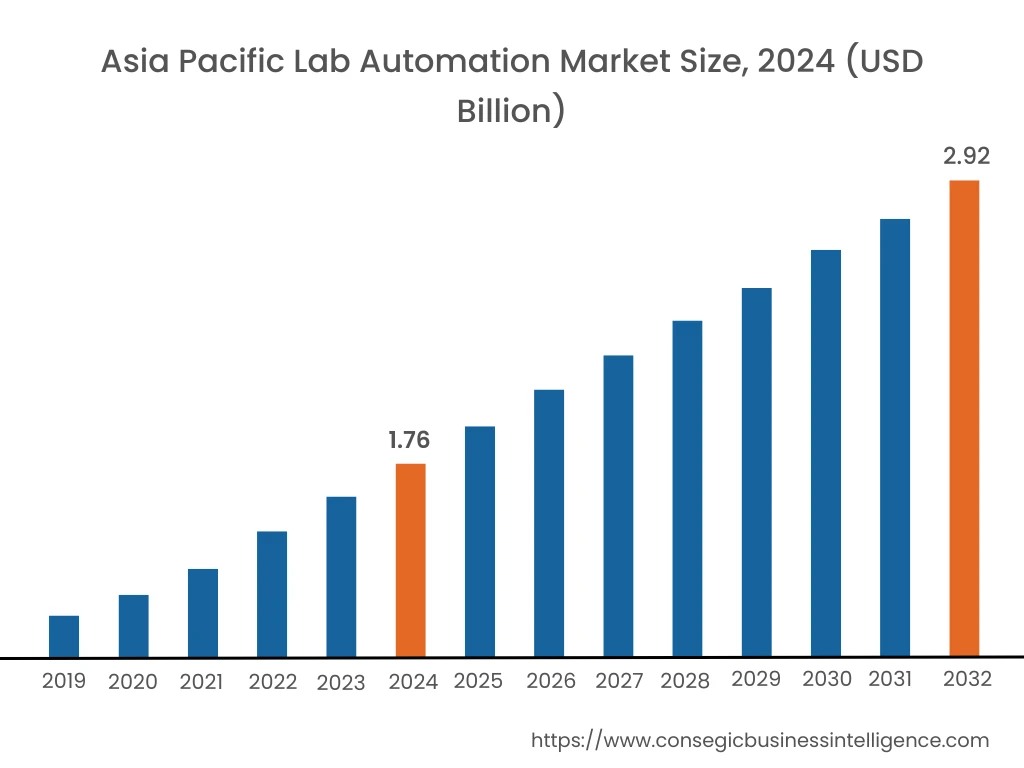
The regions covered are North America, Europe, Asia Pacific, the Middle East and Africa, and Latin America.
Asia Pacific region was valued at USD 1.76 Billion in 2024. Moreover, it is projected to grow by USD 1.84 Billion in 2025 and reach over USD 2.92 Billion by 2032. Out of this, China accounted for the maximum revenue share of 36.44%. The market in the Asia-Pacific region is driven due to driven by advancements in biomedicine and pharmaceuticals, growing healthcare industry, and rising demand for efficient diagnostics and research.
- For instance, in December 2023, Lupin Diagnostics launched a new lab in India. The lab is equipped with diagnostic technologies and offer high-quality diagnostic services for cytogenetics, molecular diagnostics, cytometry, microbiology, flow cytology, and others. Thus, the lab automation market analysis shows that the aforementioned factors are driving the lab automation market in Asia-Pacific region.
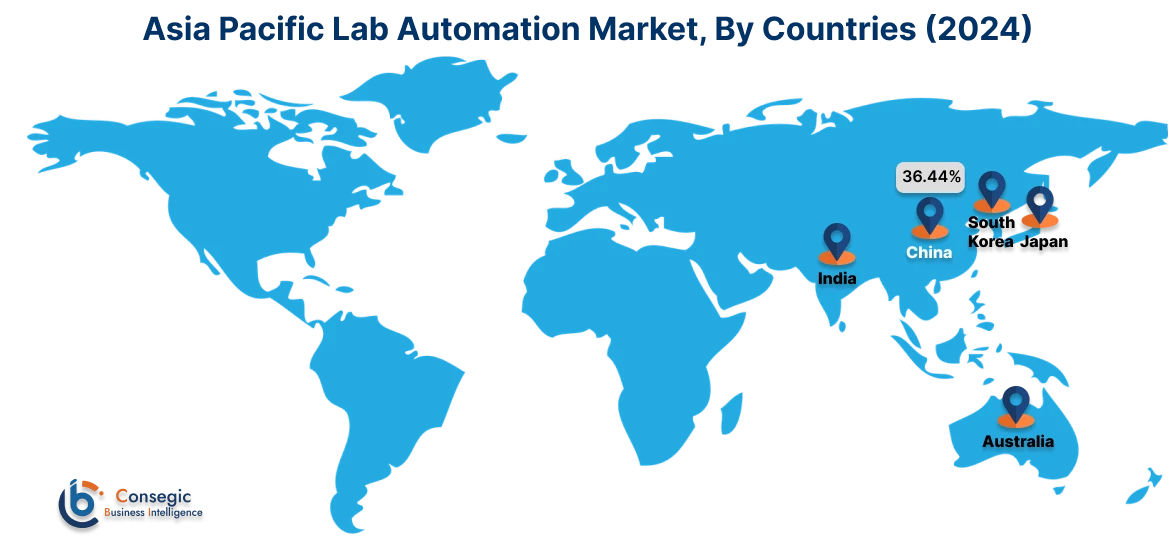
North America is estimated to reach over USD 3.70 Billion by 2032 from a value of USD 2.28 Billion in 2024 and is projected to grow by USD 2.39 Billion in 2025. The market is driven by growing need for automated labs, increased pharmaceutical and biotech research spending, and government support for life sciences.
- For instance, in May 2021, Neuberg Diagnostics launched its first laboratory in the U.S. The laboratory will focus on genomic and molecular testing that are based on new generation sequencing techniques. Thus, the aforementioned factors are boosting the market in the North America region.
Additionally, the lab automation market analysis shows that the market in Europe is driven by increased demand for automation solutions for improved accuracy, efficiency, and speed in research, healthcare, and industrial sectors. In Latin America, Middle East and Africa, the market is primarily driven by advancements in healthcare industry by enhancing diagnostic accuracy, reducing turnaround times, and improving efficiency. Thus, the aforementioned factors are driving the lab automation market expansion in the region.
Top Key Players and Market Share Insights:
The lab automation industry is highly competitive with major players providing solutions and services to the national and international markets. Key players are adopting several strategies in research and development (R&D), product innovation, and end-user launches to hold a strong position in the global lab automation market. Key players in the lab automation industry include -
- Agilent Technologies, Inc. (US)
- Aurora Biomed Inc. (US)
- BMG LABTECH GmbH (Germany)
- Danaher (US)
- Eppendorf SE (Germany)
- Hoffmann-La Roche Ltd (Switzerland)
- Hudson Robotics (US)
- PerkinElmer Inc. (US)
- Siemens Healthcare GmbH (Germany)
- Tecan Trading AG (Switzerland)
- Thermo Fisher Scientific, Inc. (US)
Lab Automation Market Report Insights :
| Report Attributes | Report Details |
| Study Timeline | 2019-2032 |
| Market Size in 2032 | USD 10.82 Billion |
| CAGR (2025-2032) | 6.8% |
| By Type |
|
| By Equipment and Software Type |
|
| By End User |
|
| By Region |
|
| Key Players |
|
| North America | U.S. Canada Mexico |
| Europe | U.K. Germany France Spain Italy Russia Benelux Rest of Europe |
| APAC | China South Korea Japan India Australia ASEAN Rest of Asia-Pacific |
| Middle East and Africa | GCC Turkey South Africa Rest of MEA |
| LATAM | Brazil Argentina Chile Rest of LATAM |
| Report Coverage |
|
Key Questions Answered in the Report
How big is the lab automation market? +
Lab Automation Market size is estimated to reach over USD 10.82 Billion by 2032 from a value of USD 6.65 Billion in 2024 and is projected to grow by USD 6.95 Billion in 2025, growing at a CAGR of 6.8% from 2025 to 2032.
What are the major segments covered in the lab automation market report? +
The segments covered in the report are type, equipment and software type, end user, and region.
Which region holds the largest revenue share in 2024 in the lab automation market? +
North America holds the largest revenue share in the lab automation market in 2024.
Who are the major key players in the lab automation market? +
The major key players in the market are Agilent Technologies, Inc. (US), Aurora Biomed Inc. (US), BMG LABTECH GmbH (Germany), Danaher (US), Eppendorf SE (Germany), F. Hoffmann-La Roche Ltd (Switzerland), Hudson Robotics (US), PerkinElmer Inc. (US), Siemens Healthcare GmbH (Germany), Tecan Trading AG (Switzerland), and Thermo Fisher Scientific, Inc. (US).
